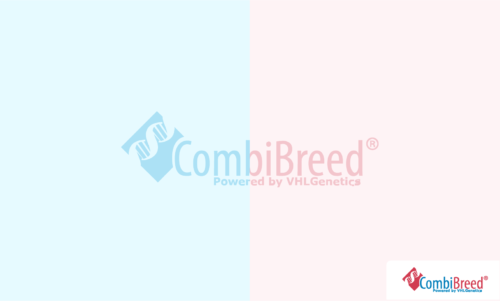Introduction to coat colours in dogs
In dogs, coat colour is a complex trait influenced by a variety of genes interacting with each other. Mutations in these genes (or loci*) can interact in intricate ways, leading to the diverse range of coat colours and patterns seen in modern dog breeds.
The original coat colour of the dog, resembling that of its ancestor the wolf, is called “agouti” and consists of a mixture of dark and light-banded hair resulting in a grey or brown appearance. These colours are produced by two types of pigment: eumelanin (dark pigment; appears dark brown or black) and phaeomelanin (light pigment; appears as brownish/red to yellow), with white hair indicating a lack of either pigment.
The mutations affecting coat colour either impact the production of these pigments or their distribution on the body. For instance, the recessive red mutation at the E locus prevents the production of dark-pigmented hairs, resulting in a uniform yellow-red body colour. Conversely, the dominant black mutation at the K locus leads to an even distribution of dark pigment across the body, giving rise to a completely black coat.
* Many coat colour genes are known as “loci” (singular: locus), and are designated with a particular letter that stands for the effect caused by the mutant allele. Particularly in breeding communities, the names of these loci are often far more well-known than the names of the genes themselves.
Tested colour and pattern loci
- A-Locus – Agouti: range of mutations that affect the distribution of dark and light pigment
- B-Locus – Brown: dark coat becomes brown
- Co-Locus – Cocoa: dark coat becomes brown, unique to the French Bulldog
- D-Locus – Dilution: dark coat becomes diluted blue/grey
- E-Locus – Extension: coat cannot produce dark fur. Also includes Grizzled and Melanistic Mask coat patterns
- I-Locus – Intensity: light coat becomes lighter cream/yellow/white
- K-Locus – Dominant Black: base coat becomes entirely dark
- M-Locus – Merle: dark coat becomes broken/mottled with light fur. Also includes the Harlequin colouration unique to the Great Dane
- S-Locus/Piebald – Formation of white spots
- Albinism – Total lack of pigment, resulting in a white coat and light eyes
- Panda White Spotting – Formation of large white spots, unique to the German Shepherd
- Roan/Ticked: Coat gains a mixture of pigmented and white hairs, gaining spots or mottling
